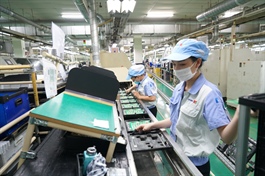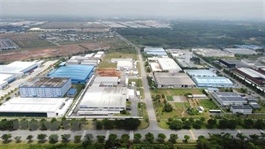Việt Nam’s economy grows 4.24 per cent in nine months of 2023
Việt Nam’s economy grows 4.24 per cent in nine months of 2023
Việt Nam’s gross domestic product (GDP) expanded by 4.24 per cent in the first nine months of this year, the General Statistics Office (GSO) said on Friday.

A customer shops at MM Mega Market An Phú's food wholesale and distribution centre in Thủ Đức District in HCM City. In the first nine months of 2023, CPI increased by 3.16 per cent over the same period last year; core inflation rose by 4.49 per cent. — VNA/VNS Photo Mỹ Phương |
The expansion is nearly the lowest 9-month GDP growth in 13 years, only higher than the same period of 2020 and 2021, which recorded growth rates of 2.19 per cent and 1.57 per cent respectively.
In Q3 alone, GDP posted a year-on-year rise of 5.33 per cent, also nearly the lowest third-quarter GDP growth in 13 years, only higher than the same quarters of 2020 and 2021.
The information was released at a conference held on Friday in Hà Nội by the GSO.
In Q3, the agro-forestry-fishery sector grew by 3.72 per cent, contributing 8.03 per cent to the country’s overall GDP growth. The industry and construction sector rose by 5.19 per cent, contributing 38.63 per cent, and the service sector grew by 6.24 per cent, contributing 53.34 per cent.
“Although the 9-month GDP growth rate is only higher than those of the same periods in 2020 and 2021 from 2011-2023, Việt Nam still witnesses an uptrend in GDP growth over the first three quarters of this year, with the rate in the first quarter being 3.28 per cent; the second quarter, 4.05 per cent; and the third quarter increasing by 5.33 per cent,” said Hương.
In nine months, the agro-forestry-fishery sector expanded by 3.43 per cent and contributed 9.16 per cent to the GDP growth. The industry and construction sector grew by 2.41 per cent, resulting in a 22.27 per cent increase in growth, and the service sector increased by 6.32 per cent, contributing to 68.57 per cent of the overall expansion.
Regarding the industry and construction area, the industrial sector faced many challenges in the context of declining global demand. The industrial sector in the nine months grew by only 1.65 per cent over the same period last year, marking the lowest growth compared to the same periods from 2011-2023. Of which, the processing and manufacturing sector grew by 1.98 per cent, also marking the lowest increase in 13 years. The construction sector grew by 6.17 per cent.
According to the Asian Development Outlook September 2023 report issued by the Asian Development Bank (ADB) on 27 September, weak external environments, including a subdued recovery in China, have hampered export-led manufacturing, thus shrinking industrial production in Việt Nam.
However, the economy remains resilient, and recovery is expected to gain momentum in the near future, driven by robust domestic consumption, which is bolstered by moderate inflation, an acceleration of public investment, and improved trade activities, the report said.
While Việt Nam’s industrial production is shrinking due to falling global demand, other sectors are forecast to display robust growth. Services are expected to continue expanding, supported by a revival in tourism and the recovery of associated services. Agriculture will benefit from rising food prices and is predicted to grow by 3.2 per cent in 2023 and the subsequent year, according to the report.
CPI up 3.16 per cent in nine months
GSO stated that the Consumer Price Index (CPI) in September rose by 1.08 per cent month-on-month, up 3.12 per cent compared to December 2022, and 3.66 per cent higher than the same period last year.
For the third quarter, the CPI posted a year-on-year increase of 2.89 per cent.
Within the quarter, housing and building materials saw an increase of 6.99 per cent; education rose by 5.95 per cent; restaurants and catering services by 5.9 per cent; and beverages and tobacco by 3.05 per cent.
Two groups witnessed a decrease in prices compared to the same period last year: post and telecommunications, which dropped by 1.12 per cent, and transportation, which declined by 2.28 per cent.
On average, in the first nine months of 2023, the CPI grew by 3.16 per cent over the same period last year, while core inflation increased by 4.49 per cent.
Hương attributed the rise in the nine-month CPI to several factors. The average airline ticket prices surged by 71.56 per cent compared to the same period last year. This was primarily due to an increase in travel demand, especially during holidays and the summer vacation.
Education fees experienced a hike of 7.28 per cent compared to the same period last year because some localities decided to increase tuition for the 2023-24 academic year.
The prices of housing and construction materials grew by 6.73 per cent over the previous year. This caused the overall CPI to jump by 1.27 percentage points, a result of the rising costs of cement, sand, and housing rentals.
Food prices inflated by 2.83 per cent, mainly due to a surge in consumer demand during the holidays. This rise contributed an additional 0.6 percentage points to the overall CPI.
Domestic electricity prices went up by 4.23 per cent owing to a higher electricity demand and EVN's decision to raise electricity tariffs by 3 per cent from 4 May 2023, resulting in a 0.14 percentage point increase in the CPI.
Conversely, several factors limited the CPI growth rate in the initial nine months of 2023. Specifically, domestic petrol prices, mirroring global trends, fell by 15.26 per cent compared to the previous year. This decline reduced the overall CPI by 0.55 percentage points.
Additionally, the domestic gas price decreased by 10.21 per cent, leading to a 0.15 percentage point reduction in the overall CPI.
























